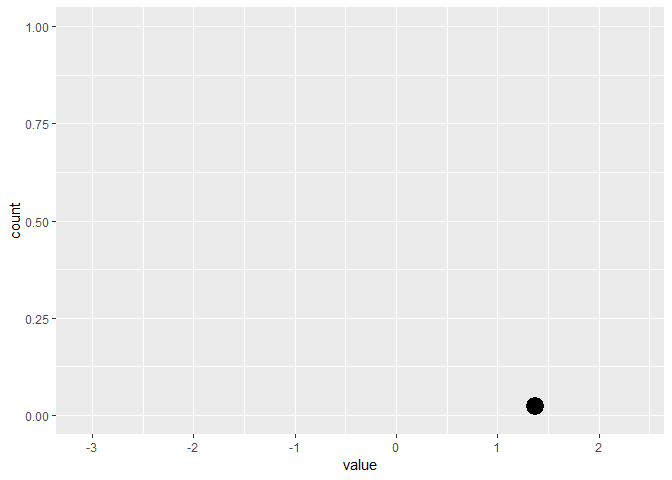Animated dot histogram, built observation by observation (using gganimate in R)
Another option is to draw the points with another geom. you will need to do some counts on your data first (and binning) but it doesn’t require making your data longer.
For example, you can use geom_point, but the challenge will be to get the dimensions of your points right, so they touch/do not touch. This depends on the device / file size.
But you can also just use ggforce::geom_ellipse to draw your dots:)
geom_point (trial and error with device dimensions)
library(tidyverse)
library(gganimate)
set.seed(42)
samples <- rnorm(100)
index <- seq(1:length(samples))
df <- tibble(value = samples, index = index)
bin_width <- 0.25
count_data <- # some minor data transformation
df %>%
mutate(x = plyr::round_any(value, bin_width)) %>%
group_by(x) %>%
mutate(y = seq_along(x))
plot <-
ggplot(count_data, aes(group = index, x, y)) + # group by index is important
geom_point(size = 5)
p_anim <-
plot +
transition_reveal(index)
animate(p_anim, width = 550, height = 230, res = 96)

geom_ellipse (Full control of point size)
library(ggforce)
plot2 <-
ggplot(count_data) +
geom_ellipse(aes(group = index, x0 = x, y0 = y, a = bin_width/2, b = 0.5, angle = 0), fill = 'black') +
coord_equal(bin_width) # to make the dots look nice and round
p_anim2 <-
plot2 +
transition_reveal(index)
animate(p_anim2)

update in the link which you provide to thomas's amazing example, you can see that he uses a similar approach - he uses geom_circle instead of geom_ellipse, which I chose because of better control for both vertical and horizontal radius.
To get the "falling drops" effect, you will need transition_states and a long duration and many frames per second.
p_anim2 <-
plot2 +
transition_states(states = index, transition_length = 100, state_length = 1) +
shadow_mark() +
enter_fly(y_loc = 12)
animate(p_anim2, fps = 40, duration = 20)

Created on 2020-04-29 by the reprex package (v0.3.0)
some inspiration from: ggplot dotplot: What is the proper use of geom_dotplot?
Try this. The basic idea is to the group the obs to frames, i.e. split by index and then accumulate the samples to frames, i.e. in frame 1 only the first obs is shown, in frame 2 obs 1 and 2, ..... Perhaps there is a more elegant way to achieve this, but it works:
library(ggplot2)
library(gganimate)
library(dplyr)
library(purrr)
set.seed(42)
# example data
samples <- rnorm(100)
index <- seq(1:length(samples))
# Put data into a data frame
df <- tibble(value=samples, index=index)
# inflated df. Group obs together into frames
df_ani <- df %>%
split(.$index) %>%
accumulate(~ bind_rows(.x, .y)) %>%
bind_rows(.id = "frame") %>%
mutate(frame = as.integer(frame))
head(df_ani)
#> # A tibble: 6 x 3
#> frame value index
#> <int> <dbl> <int>
#> 1 1 1.37 1
#> 2 2 1.37 1
#> 3 2 -0.565 2
#> 4 3 1.37 1
#> 5 3 -0.565 2
#> 6 3 0.363 3
p_gg <- ggplot(data=df, mapping=aes(x=value))+
geom_dotplot()
p_gg
#> `stat_bindot()` using `bins = 30`. Pick better value with `binwidth`.

p_anim <- ggplot(data=df_ani, mapping=aes(x=value))+
geom_dotplot()
anim <- p_anim +
transition_manual(frame) +
ease_aes("linear") +
enter_fade() +
exit_fade()
anim
#> `stat_bindot()` using `bins = 30`. Pick better value with `binwidth`.

Created on 2020-04-27 by the reprex package (v0.3.0)